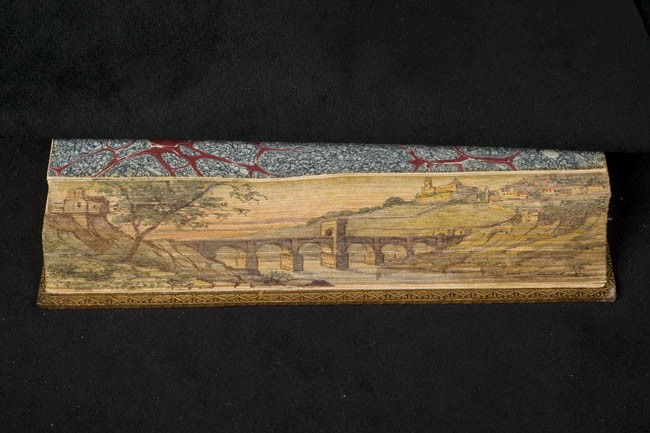Fore-Edge Painting: A Time-Honored Technique for Beautifying Books
- Melissa Gouty

- Aug 23, 2022
- 4 min read

Think you know a lot about books? Me, too. I’ve been a book lover all my life, coming from a family of readers and bibliophiles. We went to the library for Saturday outings, and a trip to a bookstore was a source of unbridled glee. (Still is.) But being an avid reader doesn’t mean that I know much about the age-old art of bookmaking.
I’d never seen or heard of “fore-edge painting” before a recent trip to the Lilly Library at Indiana University. (The “fore-edge” is the long side of the book furthest away from the spine.) The exhibit was titled, “The Eye, the Mind, & the Imagination, Part II,” and it was a look into the passion of book collectors and their specialized interests: Miniature books. Fancy, artist-commissioned bookbindings. Kids’ books. Illustrated medical books.
A few steps into the exhibit and I saw my first ever “fore-edge painted” books. I was awestruck by the discovery of a kind of book beauty that you could see without reading words.
How could I not have known about this technique of painting the edges of the pages to create stunning art? In addition to intriguing plots, quirky characters, and masterful prose, books can even flaunt fine paintings. Wow.
The advent of fore-edge painting
Title placement
Books haven’t always been produced with the same look as we know them now. In the 10th Century, the titles of books were written or tooled (impressed with heat) on the fore-edge of the book, not on the spine. Books were placed horizontally on shelves with their pages facing out so their titles could be read. It wasn’t until the 16th century, six hundred years later, that titles began to be embossed on the spines and books stored vertically.
Ownership
Once book printers and bookbinders began to put the titles on the spine, the fore-edge was free. Often, the book owner’s name or family crest was painted on the fore-edge as a means of identification. Books, after all, were valuable possessions.
Art
In the 1500s, an Italian painter and engraver, Cesare Vecellio, began to envision a different, prettier way to identify books. Instead of using the fore-edge for the title or owner’s name, Vecellio imagined painting a distinctive work of art there using the page edges as a blank canvas. When the book was closed, Vecellio’s miniature masterpiece could be viewed.
The distinctive scene painted there would be a unique way to identify the volume.
Disappearing Fore-Edge Painting
Move forward a hundred years into the 1600s. Vecellio’s original idea of painting a picture that could be seen on the edge of a book was good, but not good enough for Samuel Mearne.
Samuel Mearne has an interesting, albeit nefarious, story. He was known as one of England’s great bookbinders before the Industrial Revolution. He was a member of the Worshipful Company of Stationers and Newspaper Makers, a group that confiscated and penalized any printer or bookbinder publishing literature that went against the current political dictates on religion.
Mearne and his buddies shut down any unlicensed publisher on the grounds that these contrarian printers were producing literature in direct opposition to the King, creating dissension and stirring controversy among the people.
Samuel Mearne acted out the letter of the law and shut down dissenting publishers. But he took an unethical and criminal approach by stealing the books and pamphlets of the shut-down companies and then selling them overseas to make huge profits for himself.
However, in addition to being a bit of a scoundrel, Samuel Mearne was a talented artist. He took Vecellio’s book-painting idea and made it even more interesting. Instead of painting on the flat edge of the pages when the book was shut, Mearne fanned the pages slightly and put the paint on the inside edges. The picture became a “disappearing” or “vanishing” fore-edge painting that you couldn’t see unless you fanned the pages.
Mearne popularized the disappearing fore-edge painting on the inside edge of the page. In addition, gilt, another decorative element, was added. This gilt, which was a thin layer of gold added to the outside edges, beautified a book, protected the page edges from tears, and disguised hidden artwork.
Unrecognized artists
Fore-edge painting gained in popularity from the time of Vecellio in the 1500s and had its heyday in the early 1800s. The trend waxed and waned, but never died out completely, blossoming even in Asia for a short time when an American educator teaching in Beijing brought it to China in 1936. Painting the edges of books caught on, and lots of volumes were painted, many with Biblical scenes. The beginning of World War II, however, stopped the export of fore-edge painted books from China to America.
Sadly, fore-edge paintings are seldom signed, and little is known about the artists who created them. They are considered to be rare, and most of the known examples of fore-edge paintings are held in special collections in museums and libraries around the world.
Today, there is one known professional fore-edge painter. His name is Martin Frost. He lives in the UK and has been practicing his art for the last four decades.
From now on, I’m searching for discarded books that may have fore-edge painting on them. I’m scanning the shelves of used bookstores, rummaging through bins of torn and tattered books at yard sales, and fanning thousands of pages in the hopes that I’ll discover a vanishing treasure.








Comments